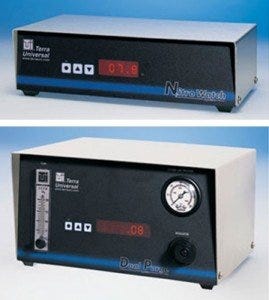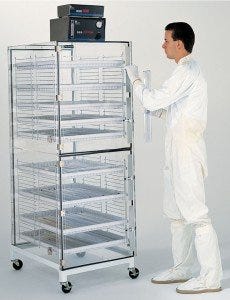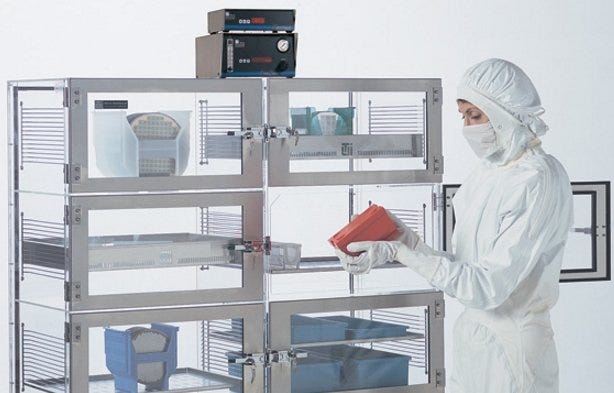Desiccators are a safe means of storage for highly-sensitive samples or materials. A continuous purge of nitrogen or other process gas creates the positive pressure environment that’s conducive to a contamination- and humidity-free desiccator. But, what if a purging system allowed your desiccator to do more than just store parts? What if it also automatically reduced nitrogen costs and prevented overpressure? Terra’s Dual Purge system does exactly that—and when it’s paired with the NitroWatch humidity control system, the relative humidity percent set-point is automatically monitored and maintained. Keep reading to find out how this dynamic duo has changed the way we use desiccators.
Why might my purging system be out of date?
Many purging systems use a high volume of nitrogen (or other process gases) in order to avoid build-up of moisture inside the desiccator, as well as infiltration of contaminants when the doors are opened. The small amount of process gas required to maintain low positive pressure is incapable of preventing influx air when the chamber is opened. Therefore, regardless of an open or closed desiccator door, the high gas level remains constant. While backflow may be prevented, this method not only wastes nitrogen when the door is closed, but also puts excess strain on the doors and seals due to the greater pressure levels.

Dual Purge and NitroWatch Control systems
What’s so different about the Dual Purge?
During the selection process of your next purging system, it’s important to consider nitrogen expense, access frequency, and humidity requirements. With the Dual Purge system, a consistent low positive pressure (about 0.05” Water Gauge) is maintained while the doors are closed using an economical amount of nitrogen/process gas. When the desiccator is accessed, a switch sensor on the open door activates the high-flow purge. Nitrogen floods the chamber, increasing the internal air pressure to minimize inflowing contaminants and moisture.
After the door is fastened, purging continues in order to force out any moisture that has entered the chamber. Automatic Relief/Bleed (RB) valves on Terra desiccators serve to relieve over-pressurization and bleed-out moisture-laden air, reducing the risk of sample or desiccator damage. Once the desiccator reaches its pre-set pressure level, the gas inflow is lowered back to its economical maintenance status. If operators suspect moisture contamination, an adjustable time delay provides manual gas inflow control to extend the duration of the high-velocity purge. Also, the “Low-Pressure” alarm works in conjunction with a flowmeter to audibly and visibly notify personnel if an incoming gas line is interrupted or disconnected.
 How does the NitroWatch control humidity?
How does the NitroWatch control humidity?
Terra’s NitroWatch humidity controller functions with the Dual Purge system to provide another layer of control by automatically managing your desired relative humidity (RH) set-point. The RH is pre-programed to the required percent and a miniaturized sensor continuously monitors and displays the RH on a digital LED screen. If the humidity level rises above the set point, NitroWatch signals the Dual Purge to initiate nitrogen purge until conditions are restored. The sensor provides 2% RH accuracy (or better) over a 10% to 90% RH range, and doesn’t require calibration.
Conclusion
For a time-saving and economical approach to efficient dry storage, the Dual Purge paired with NitroWatch not only eliminates worker supervision over delicate materials in desiccator chambers, but is proven to save up to 78% in nitrogen expenses! Set-point can be established for applications requiring a specific level, and recovery time is shortened. Personnel can program the humidity control system and let the auto-purging operation do the rest.
Learn more about Terra’s desiccator control systems.



